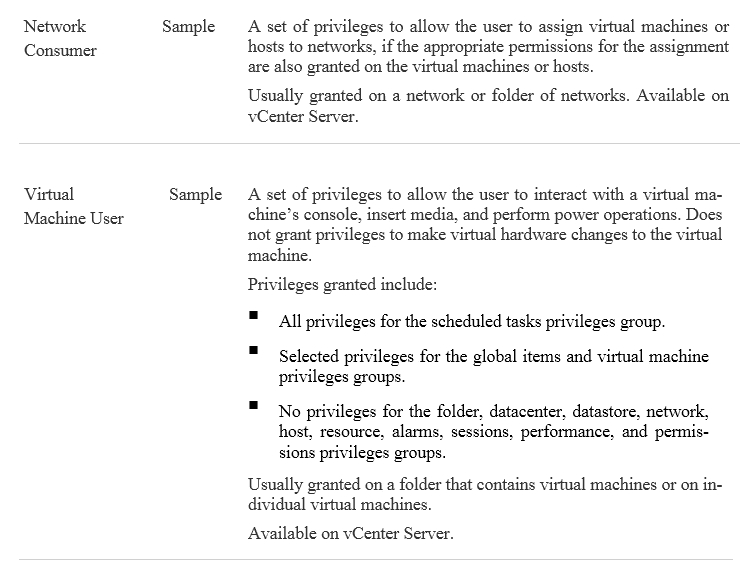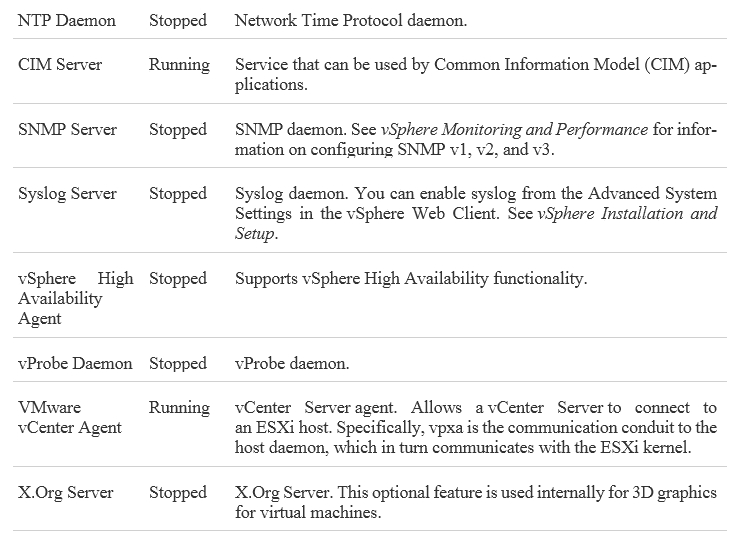VMware 2V0-621 Exam Practice Questions (P. 3)
- Full Access (243 questions)
- One Year of Premium Access
- Access to one million comments
- Seamless ChatGPT Integration
- Ability to download PDF files
- Anki Flashcard files for revision
- No Captcha & No AdSense
- Advanced Exam Configuration
Question #11
Which two methods are recommended for managing the VMware Directory Service? (Choose two.)
- AUtilize the vmdir command.
- BManage through the vSphere Web Client.
- CManage using the VMware Directory Service.
- DUtilize the dc rep command.
Correct Answer:
AB
A) dir-cli Command Reference -
The dir-cli utility allows you to create and update solution users, create other user accounts, and manage certificates and passwords in vmdir. ( link: to see vmdir commands-- https://pubs.vmware.com/vsphere-60/index.jsp?topic=%2Fcom.vmware.vsphere.security.doc%2FGUID-4FBEA58E-9492-409B-B584-
C18477F041D8.html -
)
B) Directory service associated with the vsphere.local domain. This service is a multi-tenanted, multi-mastered directory service that makes an LDAP directory available on port 11711. In multisite mode, an update of VMware Directory Service content in one VMware Directory Service instance results in the automatic update of the VMware Directory Service instances associated with all other vCenter Single Sign-On nodes via Vsphere Web Client.
AB
A) dir-cli Command Reference -
The dir-cli utility allows you to create and update solution users, create other user accounts, and manage certificates and passwords in vmdir. ( link: to see vmdir commands-- https://pubs.vmware.com/vsphere-60/index.jsp?topic=%2Fcom.vmware.vsphere.security.doc%2FGUID-4FBEA58E-9492-409B-B584-
C18477F041D8.html -
)
B) Directory service associated with the vsphere.local domain. This service is a multi-tenanted, multi-mastered directory service that makes an LDAP directory available on port 11711. In multisite mode, an update of VMware Directory Service content in one VMware Directory Service instance results in the automatic update of the VMware Directory Service instances associated with all other vCenter Single Sign-On nodes via Vsphere Web Client.
send
light_mode
delete
Question #12
What are two sample roles that are provided with vCenter Server by default? (Choose two.)
- AVirtual machine User
- BNetwork Consumer
- CContent Library Administrator
- DStorage Administrator
Correct Answer:
AB

Reference:
http://pubs.vmware.com/vsphere-4-esx-vcenter/index.jsp?topic=/com.vmware.vsphere.dcadmin.doc_41/vsp_dc_admin_guide/ managing_users_groups_roles_and_permissions/r_default_roles_for_esx_esxi_and_vcenter_server.html
AB

Reference:
http://pubs.vmware.com/vsphere-4-esx-vcenter/index.jsp?topic=/com.vmware.vsphere.dcadmin.doc_41/vsp_dc_admin_guide/ managing_users_groups_roles_and_permissions/r_default_roles_for_esx_esxi_and_vcenter_server.html
send
light_mode
delete
Question #13
Which three services can be enabled/disabled in the Security Profile for an ESXi host? (Choose three.)
- ACIM Server
- BSingle Sign-On
- CDirect Console UI
- DSyslog Server
- EvSphere Web Access
Correct Answer:
ACD


Reference:
https://pubs.vmware.com/vsphere-60/index.jsp?topic=%2Fcom.vmware.vsphere.security.doc%2FGUID-37AB1F95-DDFD-4A5D-BD49-3249386FFADE.html
ACD


Reference:
https://pubs.vmware.com/vsphere-60/index.jsp?topic=%2Fcom.vmware.vsphere.security.doc%2FGUID-37AB1F95-DDFD-4A5D-BD49-3249386FFADE.html
send
light_mode
delete
Question #14
An administrator would like to use the VMware Certificate Authority (VMCA) as an Intermediate Certificate Authority (CA). The first two steps performed are:
✑ Replace the Root Certificate
✑ Replace Machine Certificates (Intermediate CA)
Which two steps would need to be performed next? (Choose two.)
✑ Replace the Root Certificate
✑ Replace Machine Certificates (Intermediate CA)
Which two steps would need to be performed next? (Choose two.)
- AReplace Solution User Certificates (Intermediate CA)
- BReplace the VMware Directory Service Certificate (Intermediate CA)
- CReplace the VMware Directory Service Certificate
- DReplace Solution User Certificates
Correct Answer:
AC
Use VMCA as an Intermediate Certificate Authority
You can replace the VMCA root certificate with a third-party CA-signed certificate that includes VMCA in the certificate chain. Going forward, all certificates that
VMCA generates include the full chain. You can replace existing certificates with newly generated certificates. This approach combines the security of third-party
CA-signed certificate with the convenience of automated certificate management.
Procedure -
Replace the Root Certificate (Intermediate CA)
The first step in replacing the VMCA certificates with custom certificates is generating a CSR and adding the certificate that is returned to VMCA as a root certificate.
Replace Machine SSL Certificates (Intermediate CA)
After you have received the signed certificate from the CA and made it the VMCA root certificate, you can replace all machine SSL certificates.
Replace Solution User Certificates (Intermediate CA)
After you replace the machine SSL certificates, you can replace the solution user certificates.
Replace the VMware Directory Service Certificate
If you decide to use a new VMCA root certificate, and you unpublish the VMCA root certificate that was used when you provisioned your environment, you must replace the machine SSL certificates, solution user certificates, and certificates for some internal services.
Replace the VMware Directory Service Certificate in Mixed Mode Environments
During upgrade, your environment might temporarily include both vCenter Single Sign-On version 5.5 and vCenter Single Sign-On version 6.0, you have to perform additional steps to replace the VMware Directory Service SSL certificate if you replace the SSL certificate of the node on which the vCenter Single Sign-
On service is running.
Reference:
https://pubs.vmware.com/vsphere-60/index.jsp?topic=%2Fcom.vmware.vsphere.security.doc%2FGUID-5FE583A2-3737-4B62-A905-5BB38D479AE0.html
AC
Use VMCA as an Intermediate Certificate Authority
You can replace the VMCA root certificate with a third-party CA-signed certificate that includes VMCA in the certificate chain. Going forward, all certificates that
VMCA generates include the full chain. You can replace existing certificates with newly generated certificates. This approach combines the security of third-party
CA-signed certificate with the convenience of automated certificate management.
Procedure -
Replace the Root Certificate (Intermediate CA)
The first step in replacing the VMCA certificates with custom certificates is generating a CSR and adding the certificate that is returned to VMCA as a root certificate.
Replace Machine SSL Certificates (Intermediate CA)
After you have received the signed certificate from the CA and made it the VMCA root certificate, you can replace all machine SSL certificates.
Replace Solution User Certificates (Intermediate CA)
After you replace the machine SSL certificates, you can replace the solution user certificates.
Replace the VMware Directory Service Certificate
If you decide to use a new VMCA root certificate, and you unpublish the VMCA root certificate that was used when you provisioned your environment, you must replace the machine SSL certificates, solution user certificates, and certificates for some internal services.
Replace the VMware Directory Service Certificate in Mixed Mode Environments
During upgrade, your environment might temporarily include both vCenter Single Sign-On version 5.5 and vCenter Single Sign-On version 6.0, you have to perform additional steps to replace the VMware Directory Service SSL certificate if you replace the SSL certificate of the node on which the vCenter Single Sign-
On service is running.
Reference:
https://pubs.vmware.com/vsphere-60/index.jsp?topic=%2Fcom.vmware.vsphere.security.doc%2FGUID-5FE583A2-3737-4B62-A905-5BB38D479AE0.html
send
light_mode
delete
Question #15
Which three options are available for ESXi Certificate Replacement? (Choose three.)
- AVMware Certificate Authority mode
- BCustom Certificate Authority mode
- CThumbprint mode
- DHybrid Deployment
- EVMware Certificate Endpoint Authority Mode
Correct Answer:
ABC
ESXi Certificate Replacement -
For ESXi hosts, you can change certificate provisioning behavior from the vSphere Web Client.

Reference:
https://pubs.vmware.com/vsphere-60/index.jsp?topic=%2Fcom.vmware.vsphere.install.doc%2FGUID-4469A6D3-048A-471C-9CB4-518A15EA2AC0.html
ABC
ESXi Certificate Replacement -
For ESXi hosts, you can change certificate provisioning behavior from the vSphere Web Client.

Reference:
https://pubs.vmware.com/vsphere-60/index.jsp?topic=%2Fcom.vmware.vsphere.install.doc%2FGUID-4469A6D3-048A-471C-9CB4-518A15EA2AC0.html
send
light_mode
delete
All Pages
